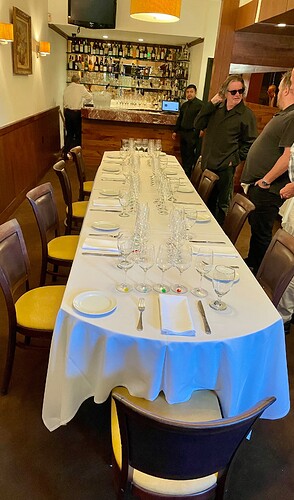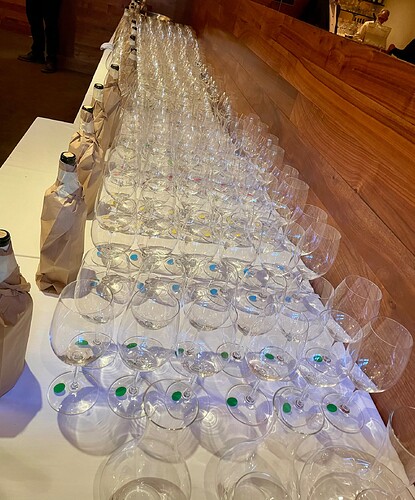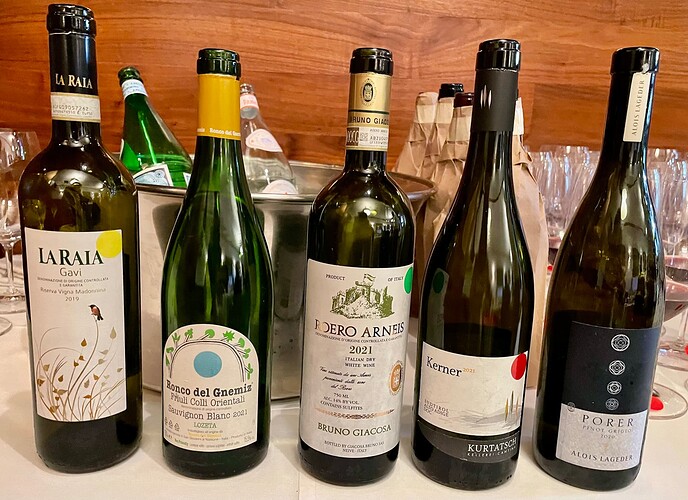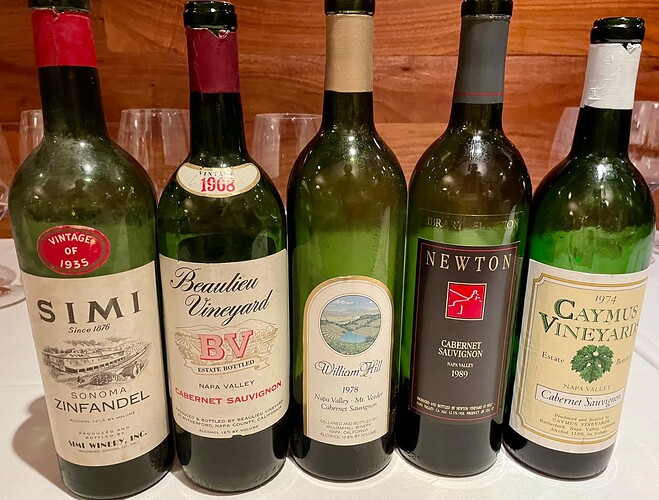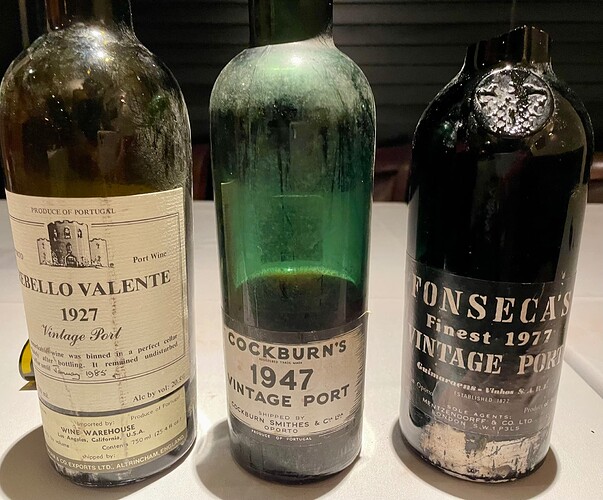For the past few decades, there have been some one of a kind wine tastings/ dinners held in the Los Angeles area put on by an avid wine collector of extra special wines. Word has gotten around and many of us have heard about them and know some of the incl people who have attended them.
Additionally, and concurrently, there was a dinner group formed consisting of top wine collectors/ industry people who have met at varying times over the decades and presently once a month with one of the members being responsible for the wines and dinner. They call themselves the Royal Order of Purple Palate, ROPP. A good friend is one of those current members and his turn to host just came up.
Since there were a couple of the members unable to attend, I was invited as a fill in and graciously, humbly accepted.
The dinner was held in the private dining room of the iconic Hollywood restaurant of Marino Ristorante on Melrose. Mario and Sal, sons of the original owner, Ciro aka Mario, personally orchestrated and served the dinner along with some of their staff to the 10 of us.
There were 23 total wines, all served blind, and all were either purchased from the source or the original distributor and stored for as long as 40 years in my friend’s classic and state of the art wine cellar.
Upon arrival, we were served champagne from an obscured magnum by the competent and good guy, Maitre D’ and Sommelier Paul Sherman, while our host skillfully used Port tongs to remove the necks of the 3 concealed Port bottles that would cap off our dinner.
After some discussion and lots of wild guesses, the champagne was revealed and a personalized story about the producer was provided by the one who had contributed the bottle before we moved on to 5 flights of wines paired with each course starting out with 5 whites, then flights of 4, 5 and 5 reds before the final 3 Ports.
2004 CHAMPAGNE RENE GEOFFROY EXTRA BRUT in magnum- blind; 70% Chardonnay and 30% Pinot Noir, aged 7 1/2 years on the less; no ML; disgorged 2/17 and dosed at 2 gpl; this was really good being super rich, possessing bright acidity and wonderful balance while giving up ripe, mature and ready notes of lemon, nectarine and yellow apple that were enhanced by an accent of ginger and spice; its lovely creamy mousse added a tactile sense that completed the sensory treat and I offered my glass for another taste; my first thought was Cristal and when another voiced ’06 Cristal, I thought we had an ID, but I called it ’09; then the bottle came around and it was obviously not Cristal with its dark glass and a shape that reminded me of Dom Ruinart magnums.
First Course: Welcome from the Sea, an assortment of tasty small bites while 5 white wines were poured blind and we learned, once finished, they were all from across the top of Northern Italy:
2019 LA RAIA GAVI RISERVA VINA MADONNINA- blind; this comes from 20+ year old vines, is aged a year on the lees in stainless then bottled and aged for 6 more months; this was a lovely, refreshing wine that featured gentle notes of flint and mineral accented citrus and green apple with an underlying spicy component; a great start for this flight.
2021 RONCO del GNEMIZ LOZETA SAUVIGNON BLANC COLLI ORIENTALI del FRUILI- blind; this comes from vineyards replanted in 2009 near the town of Udine where I visited a few years ago and was fortunate to sample some of the excellent SBs made by this producer and no, I did not identify it; it is aged for 12 months in barriques and delivered unctuous petrol laced tangerine, orange zest, honeydew melon and lime all the way to the back end while its creamy, oily texture adds more allure.
2021 BRUNO GIACOSA ROERO ARNEIS- blind; this was an amazing wine and my fav of the fight and one of my favs on the night; in a few words, its was peaches and cream, but there’s so much more and therefore more words needed to describe it; they would include: it was rich and full bodied with a super oily texture that may have been its hallmark while it gave mineral infused lemon, yellow apple, pineapple and peach being most prominent in the taste profile, but that viscous mouthfeel kept my sensory preceptors on alert throughout.
2021 KELLEREI KURTATSCH CANTINA KERNER ALTO ADIGE- blind; Kerner is a cross between Schiava (Vernatsch) and Riesling and for me, this was more like a Riesling with its petrol, mineral and flint accented lemon, lime, orange and soft acidity; it had 2 gpl of residual sugar.
2020 ALOIS LAGEDER PORER PINOT GRIGIO ALTO ADIGE- blind; winemaker notes: “One part of the grapes was pressed immediately after their arrival at the estate, another part was kept on the skins for 15 hours and the third part was in contact with stems and skins for about one year”; all of the other wines in this flight were straw yellow in color, but this one was more yellow gold complimenting the taste profile which was super golden delicious; it gave coconut, almond and mineral accented apricot, tangerine, pear and lime notes.
Some asked for hints as to varietal and place and our host only offered tidbits of info, but there were a few who narrowed in on the varietals and regions. This is when I realized how advanced some of the palates were in this group and how much more I have to learn. I added a slice of humble pie to this course.
Second Course: Sweetbreads, Porcini paired with 4 red wines blind which turned out to be all from Northern Piedmont:
2007 ANTONIOLO OSSO SAN GRATO GATTINARA- blind; this comes from 5 hectares in the Osso San Grato cru from vines that were planted in 1960; once pressed, they are left to ferment with a 14-16 day period of maceration on the skins and the must was interestingly pumped over with automatic sprinklers; maturation began in oak barrels for 30 months, finishing in the bottle for 1 year before release; perhaps more importantly, this is truly cool climate Nebbiolo and as such, presented with more for a “Burgundian” like profile with its soft acidity; following its dark purple color with a slight red rim came aromas of seemingly dried red cherry fruit, both of which fooled me into thinking it was a lot older; the taste was more of the same, but with more fresh and ripe fruit. Loved it.
1971 NERVI VIGNA MOLSINO GATTINARA- blind; this gem comes from the oldest Gattinara DOCG producer in the region {1906} and is also a source of cool climate Nebbiolo from mineral rich soil; the nose had smoke and burnt dried red cherry that gracefully evolved into mineral, mint, tobacco and earthy red and black fruit on the palate; it actually improved with time and its soft mouthfeel and extended finish made for a wondrous experience.
1964 MONSECCO RAVISSA RISERVA SPECIALE GATTINARA- blind; it had a fading light red color and aromas of aged, fortified fruit as found in a Port; once tested, it gave flavorful dried, burnt red cherry along with accents of licorice and black truffle; this got better with time and when I went back to it 30 minutes after first sampling it, it was marvelous.
1955 ANTONIO VALLANA e FIGLIO SPANNA CAMPI RAUDI- blind; the color, nose and taste suggested this had some age as it had a browning red purple color and some musty, dusty earthy dried black currant that continued to the back end; it actually got better and was pretty decent albeit showing some advanced maturity.
Again, there were questions for hints and guess all over the place as to what the varietal{s} was/ were and as I recall, nobody actually got it until a lot more information was provided, but the process was interesting and insightful.
Third Course: Maccheroncini Oxtail paired with 5 blind reds which turned out to be Barbarescos from Gaja from 1961 to 1989:
1989 GAJA SORI SAN LORENZO BARBARESCO- blind; sporting a dark, vibrant purple color, this first offered aromas of violets and serious, mature dark fruit which on the palate translated into wonderful dried black currant and plum; it was full bodied with lots of complexity and layered depth and perhaps its hallmark was its amazing balance; after tasting through the entire flight, this was one of my favs.
1985 GAJA BARBARESCO- blind; the vibrant dark purple color suggested something pretty serious and that was so true as the nose seemed almost Port like and the taste profile was super serious with delicious dark chocolate accented dried black cherry most prevalent; it was full bodied and actually had a bit of weight while finishing with everything coming together for a welcomed final thrust. Impressive.
1978 GAJA BARBARESCO- blind; this was the first vintage where barriques were used; the nose had a bit of dusty, rusty, dried fruit theme that gave way to some lovely cardamon and spice laden dark fruit; on the palate, I also detected some licorice and leather laden dried black cherry/ berry; as with the others, it was full bodied with some nice finesse to ease up on the intensity.
1971 GAJA BARBARESCO VENDEMMIA- blind; “Vendemmia” is additionally shown on this label in the area that usually houses “Barbaresco”; amidst some controversy about the origin, the Italians believe they discovered vendemmia because it comes from the Latin term Vinum e demia. Vinum means wine, and demia comes from the word demere, which means to take. So, it specifically means harvesting grapes to turn them into wine. Regardless, this wine was made with a high degree of excellence as it showcased mature dark fruit notes with spicy, dried black plum and black currant notes while being delivered in a soft and smooth textured medium; it was the consummate experience and tied for my fav of this flight until I re-tasted the ’89 and the ‘61.
1961 GAJA BARBARESCO- blind; can it get any better as we move through these splendid wines? I got a resounding “yes” when I first approached this one which was even more impressive when I saw the vintage; the color was light red brick which strongly suggested some age and I guessed 1940-50s; it had an inviting nose of leather, cigar, earth and a hint of violets to compliment the wondrous dark fruit that had just a touch of sweetness; after re-tasting this marvelous flight, this was my winner.
Again, the table discussion kept looking for hints, but our host didn’t relent and left us to our best guesses, many of whom had a much better recognition that I did. I do not believe anyone got these coming from the same producer, but a couple had it as Nebbiolo.
Fourth Course: Waugh Beef Cheeks, Truffled Mash Potatoes paired with 5 more red wines which were supposed to be California Cabernets, but one was a 1935 Zinfandel and the others ranged from 1968 to 1989:
1935 SIMI WINERY ZINFANDEL SONOMA- blind; 12.5 % abv; this winery made the first wine from Sonoma County grapes back in 1876 and this was our oldest bottle to this point and for the day regarding the unfortified wines; from the browning purple color and earthy dried fruit aromas, there was no doubt this was an older wine; our host realized he had pulled this in lieu of the Cabernet, but upon researching the wine, I discovered it had been mentioned as one of three Zinfandels made in the style of Cabernet in that day by Charles Lewis Sullivan in his book, "Zinfandel: A History of a Grape and Its Wine,”.
1968 BEAULIEU VINEYARD CABERNET SAUVIGNON NAPA- blind; this bottle seemed to be showing its age more than most others on this day; the nose had some stewed/ musty green bell pepper pyrazine notes and Port like aromas and the taste had more approachable dried currant with cigar and leather accents.
1978 WILLIAM HILL CABERNET SAUVIGNON MT. VEEDER NAPA- blind; the color was a still viable dark purple and the nose had decent dark chocolate and black cherry/ berry which continued on and throughout; it was showing beautifully.
1989 NEWTON “LIBRRY SELECTION” CABERNET SAUVIGNON NAPA- blind; decent mature notes of dried dark fruit along with nice complexity and depth were the highlights of this enjoyable wine.
1974 CAYMUS CABERNET SAUVIGNON NAPA- blind; this was my fav of the flight as it had lots of goodness to share, starting off with a so viable dark purple color and aromas of earth and coconut accented black currant; it was soft and easy on the palate and finished gracefully with everything coming together.
I did not have as much time to hang out with these wines so my notes are more reflective of what I got the first couple of times through on top of some palate fatigue setting in.
Dessert Course: Strawberry Rhubarb Streusel paired with 3 Vintage Ports:
1927 REBELLO VALENTA VINTAGE PORT- blind; our oldest bottle of the 24 and coming from the excellent 1927 vintage; brownish orange color; the nose had wondrous sweet cranberry/ cherry that came in more like Smith Brothers licorice cough drops with a cherry on top once tasted; it had a viscous texture and finished with more cranberry/ cherry as the licorice faded out.
1947 COCKBURN’S VINTAGE PORT- blind; falling in line with the 1927, this was another fabulous Port that gave generously and often with pleasing dark chocolate enhanced black cherry/ berry; it had serious complexity, layered depth and extraordinary length.
1977 FONSECA VINTAGE PORT- blind; although I did not recognize it, thanks to our host, others and a prudent buy for my cellar, I’d had this a few times and always enjoyed it as was the case with this bottle; in fact, it was absolutely fabulous and remains to be one of my all time favorite Ports, albeit in its “youthful” state; following its inky dark purple color came aromas of spicy, mocha and cedar accented blackberry/ cranberry/ cherry/ plum which continued on to the back end and contributed to a fantastic finish; the mouthfeel was equally magnificent being almost creamy, soft and smooth; what a way to end an amazing evening.
Cheers,
Blake
